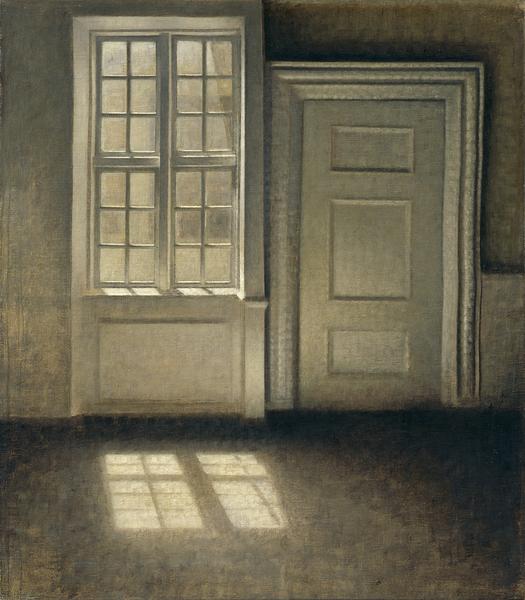The Copenhagen district of Christianshavn proved to be of great importance for Vilhelm Hammershøi’s artistic development: it was here that interior scenes became the central motif in his art, and here he created some of his most enduringly famous works.
Hammershøi got to live at two different addresses in Christianshavn: at Strandgade 30 from 1898 to 1908 and at Strandgade 25 in the years 1913 to 1916. The David Collection contains exclusively works depicting views from Strandgade 30 - this work as well as
B 307 and
B 309.
Sitting Room. Study in Sunlight was painted in one of the smaller living rooms in the northeast wing of Hammershøi’s flat. The tall, narrow window faces the courtyard beyond, and the closed door leads out to the exterior gallery that connected the two wings of the house. Hammershøi has carefully staged his chosen subject, emptying the room of furniture and objects and of any human presence. Everything has been pared away, leaving the room in its clearest, purest form and allowing the artist to direct his attention to what interests him: the light falling in through the window, creating oscillating optic effects on the floor, walls, panelling and door.
The window is a recurring motif in nineteenth-century Northern European art, acting as a metaphor for, among other things, a yearning to see other places and for thresholds between outside and inside, the near and the faraway. In
Sitting Room. Study in Sunlight, the window is shut, and it seems impossible to open, as Hammershøi has omitted to paint in any fittings. The window also does not offer any clear view of a world outside; everything is blurred and indefinable.
Inv. no. B 312
Published in:
Fortegnelse over arbejder af Vilhelm Hammershøi, [2], Kunstforeningen April-Maj 1916, København 1916, cat.no. 62, p. 7;
Sophus Michaëlis and Alfred Bramsen: Vilhelm Hammershøi. Kunstneren og hans værk, København 1918, cat.no. 283, pp. 63, 105;
Alfred Bramsen: Udvalg af Vilh. Hammershøis arbejder, København 1930, cat.no. 27, p. 9;
Erik Zahle: ”Billedkunst” in C.L. Davids Samling. Nogle Studier, [1], København 1948, p. 207;
Det besjälade rummet, Malmö Museum, Malmø 1975, p. 24;
Knud Voss and Verner Aspenström: Vilhelm Hammershøi, Prins Eugens Waldemarsudde, Stockholm 1976, cat.no. 30;
Hanne Finsen, Inge Vibeke Raaschou-Nielsen: Vilhelm Hammershøi: en retrospektiv udstilling, Ordrupgaard, Charlottenlund 1981, cat.no. 112, p. 137;
Kirk Varnedoe: Northern light. Realism and symbolism in Scandinavian painting, 1980-1910, Brooklyn Museum, New York 1982, cat.no. 33, p. 131;
Poul Vad in Kjeld von Folsach and Nana Lund (eds.): Dansk kunst i Davids Samling – fra Philipsen til Saxbo, København 1995, cat.no. 38, pp. 106-107;
Anne-Birgitte Fonsmark et al.: Vilhelm Hammershøi, 1864-1916. Danish painter of solitude and light, Ordrupgaard, Charlottenlund, Musée d’Orsay, Paris, Solomon R. Guggenheim Museum, New York 1998, cat.no. 45, p. 111;
Felix Krämer, Ulrich Luckhardt, Barbara Ludwig: Vilhelm Hammershøi, Hamburger Kunsthalle, Hamburg 2003, cat.no. 41, pp. 75, 154-155;
Bente Scavenius and Jens Lindhe: Hammershøis København, Kunstforeningen GL STRAND, København 2003, p. 68;
Tone Sinding Steinsvik, Ida Lorentzen, Bente Scavenius: Den forunderlige stillheten: Ida Lorentzen (f.1951), Vilhelm Hammershøi (1864-1916), Stiftelsen Modums Blaafarveværk, Modum 2005, cat.no. 56, p. 89;
Felix Krämer, Naoki Sato and Anne-Birgitte Fonsmark: Hammershøi, Royal Academy of Arts, London 2008, cat.no. 48, pp. 48, 106, 153;
Anne-Birgitte Fonsmark, Jacob Bach Riis (eds.): Hjemme hos Hammershøi, Ordrupgaard, Charlottenlund 2016, cat.no. 68, p. 35;
Henrik Wivel: Hammershøi i Davids Samling, København 2017, pp. 80-81;
Annette Rosenvold Hvidt and Gertrud Oelsner: Vilhelm Hammershøi. På sporet af det åbne billede, København 2018, p. 220;
